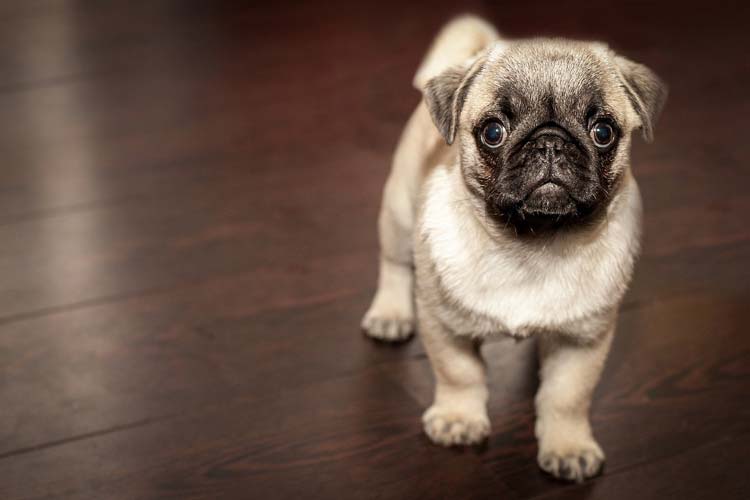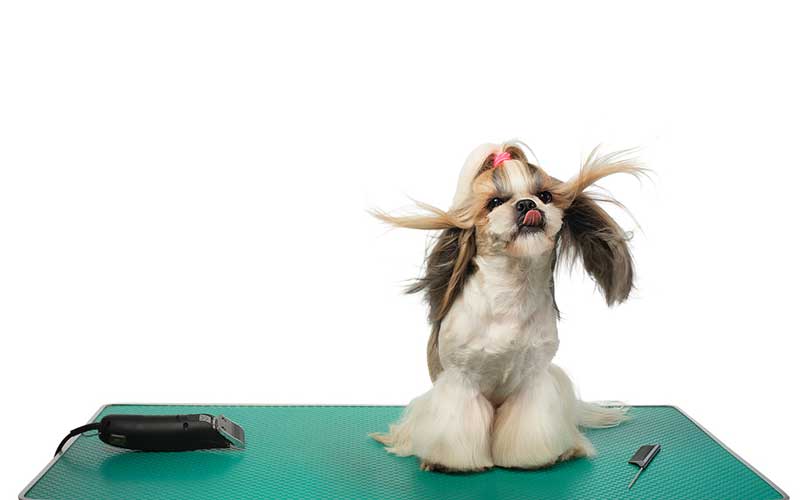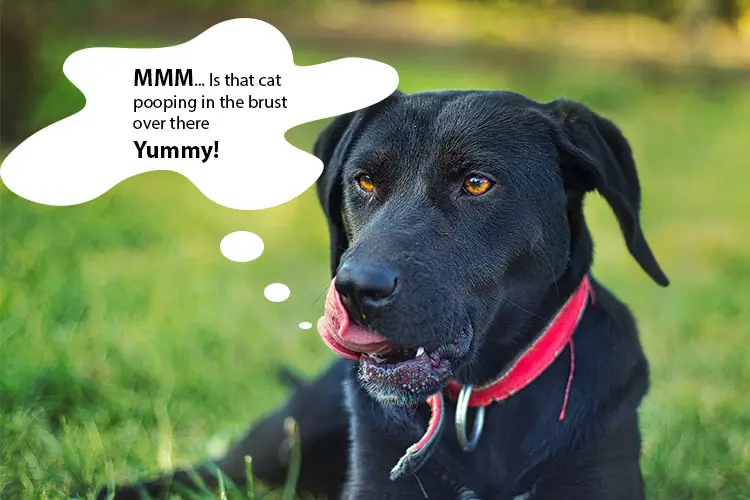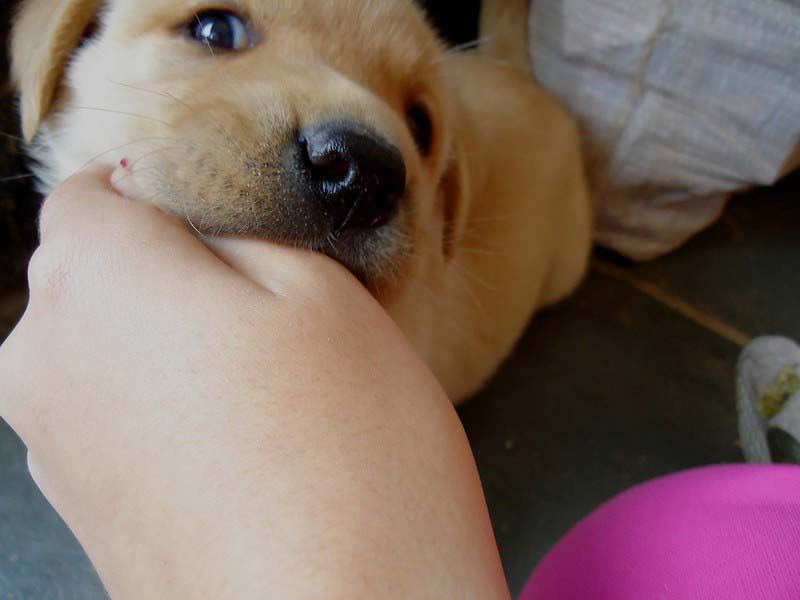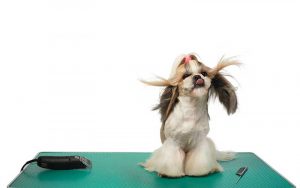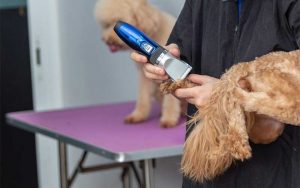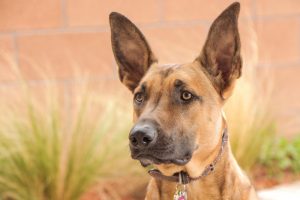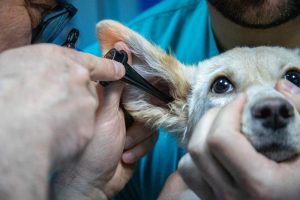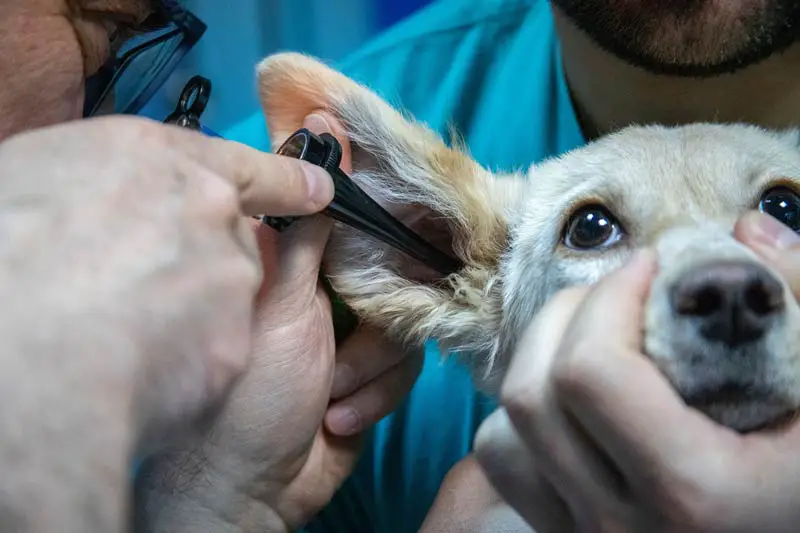
Page Contents
Dog Earwax Color Chart
Knowing your dog’s earwax color can be helpful to distinguish healthy and unhealthy signs and symptoms of any underlying health condition. After all, your dog can’t always look after themselves and they need you to check on their physical condition most of the time.
So, what do earwax colors signify on your dog? Let’s look at some of the most common colors and what they mean (and what you should do about it):
| Your Dog Ear Wax Color | What It Means |
|---|---|
| Yellow | Typically normal |
| Brown | Brown earwax should have a neutral smell to be considered normal |
| Gray | Gray-colored dog earwax means that it's either dirty or infected |
| Green | Fungal infections are likely happening in your dog's ear |
| Red | Red earwax typically indicates bug bites, ear injury, or even pruritus |
| Black | Caused by yeast or bacterial infections |
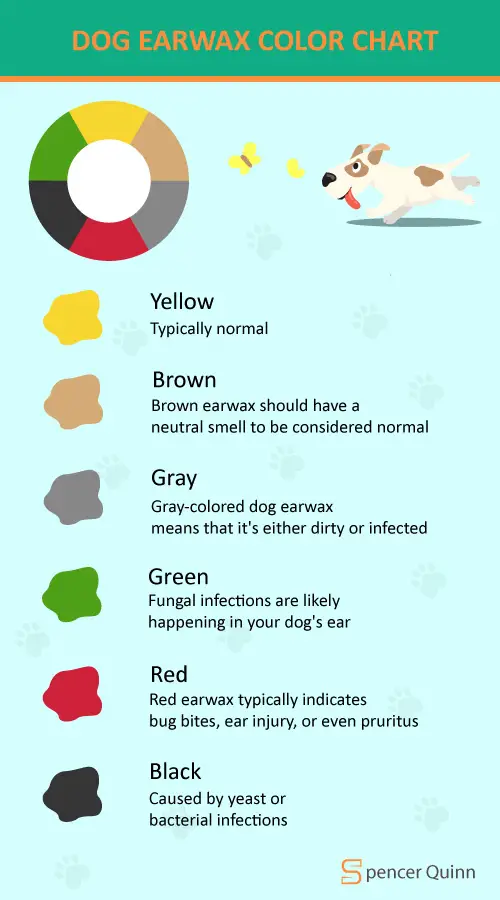
Yellow
Generally, it can be hard to tell if your dog’s earwax is normal when it’s yellow, but if it is lighter than the usual brown color and doesn’t smell anything off-putting, it is a yellow earwax rather than brown. There should also be a pink-colored outer ear if you visually inspect your dog’s ears.
See also:
If your dog’s earwax color is yellow, it is typically normal unless your vet inspects and finds it as a sign of ear infection. If your dog’s ears get redness or swelling, it is likely that they could have an ear infection, especially if they feel uncomfortable.
Brown
Brown earwax signifies something healthy. The most normal color of earwax for a dog is light brown. What’s more, your dog is less likely to have an ear infection if it doesn’t smell bad – the brown earwax should have a neutral smell to be considered normal.
However, do check for signs of infection, such as inflammation and odor. Usually, the odor comes from bacteria or any other source of ear infection. If you aren’t sure, it’s best to have your dog checked by the vet so that they can diagnose your canine friend properly.
Gray
Gray-colored dog earwax means that it’s either dirty or infected. The first step to knowing if it is an infection or not is to try cleaning your dog’s ears and see what happens afterward. Usually, it could just be dirt picked up from random places.
If your dog’s earwax returns to the normal light brown color or yellow then it’s safe to say that the gray color was just because of dirt. However, if the color doesn’t change, you should go to your vet and consult them because it could be a sign of an ear infection.
Green
Fungal infections are likely happening in your dog’s ear if they have green earwax. It could also be a yeast infection – especially if it smells bad (same with fungal infections). If you find your dog has green-colored earwax, you should get them to the vet to work on the ear infection.
Red
You’d likely associate red earwax with blood and infections – and you might be right. Red earwax typically indicates bug bites, ear injury, or even pruritus, which is a kind of skin disease found in dogs. Pruritus is typically caused by mites, food allergies, fleas, and the like.
Your veterinarian will recommend a treatment for your dog’s ear infection (or pruritus if this was the diagnosis) so you should get them to the vet clinic right away.
Black
Much like green-colored earwax, if you spot a black or dark brown color on your dog’s earwax, it will likely be caused by yeast or bacterial infections. After all, you’ve seen moldy food become black, right? Spoiled food could have either a green or black appearance, which explains this color.
Similar to most of the above-mentioned earwax colors, you should take your dog to the vet for a consultation to treat their ear infection.
How to clean dog ear
Cleaning a dog’s ear can be troublesome – especially for those who aren’t very tame and can get easily distracted. For that reason, it’s best to get help from a veterinarian or expert pet handler. To clean a dog’s ear, here are the steps you need to do to ensure your dog’s safety:
1. Have the doctor inspect the dog. The first step you need to do is to ensure that the doctor identifies that the eardrum is not injured or anything. This will play a part in what type of ear cleaning method should be used for the safety of the dog.
2. Choose the appropriate ear cleaning method. Saline solutions and commercial ear cleaners are two of the most common ways to clean your dog’s ears. You should ask your vet about which solution works best for your dog’s ears to avoid damaging them.
If your dog’s eardrums have some sort of injury then saline solution usually works best for them. This will help to prevent damage and irritation from going under the dog’s eardrum. However, a commercial ear cleaner will do the job for those dogs with no damage to their eardrum at all.
3. Hold your dog’s ears and pour the ear cleaning solution. With the amount depending on the instructions, simply hold up your dog’s ears and pour the chosen ear cleaning solution or formula.
4. Gently squish the bottom part of your dog’s ears. This will ensure that the cleaning solution is working properly. Don’t press too hard to avoid making your dog feel uncomfortable. This step will make the leftover wax inside your dog’s ear loosen up so that it will be easy to drain out of their ears.
5. Pick up the debris using cotton balls. Use them as gently as possible on the part of the ear where you placed the solution and start removing the debris that was driven out by the cleaning solution. Moreover, clean the folds of the ear as well because they can also get dirty.
Keep in mind: don’t put your cotton ball too deep into the ear. Moreover, it’s better to use cotton balls than gauze to avoid tissue damage. Cotton balls are typically softer so they won’t hurt your dog’s ears when you try to clean them.
6. Lubricate the ears if they get dry again. If there is still a bit more wax debris inside the ears, feel free to add a bit more of the cleaning solution into the ear and repeat the process that we mentioned above. Don’t pour a lot of the solution into the dog’s ear.
7. Use a Q-tip once the cotton balls pick up less wax debris. If you see that your cotton balls are picking up a far lesser amount of debris from your dog’s ears, it’s time to use cotton buds or Q-tips to thoroughly get into the smaller areas. Don’t push too hard to avoid injuries and only go around gently into the ear.
8. Repeat the above-mentioned steps on the other ear. If you’re done on one side, do the other ear in the same way. Sometimes, your dog might also shake their head mid-way to make them feel good, but it also depends on your dog’s mood.
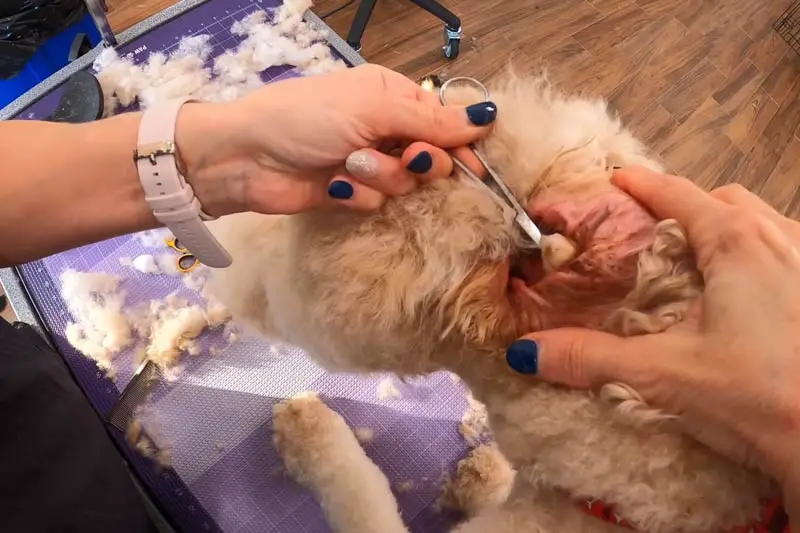
Dog Ear Wax Removal Home Remedy
Some dog breeds need more ear-cleaning than others and are, therefore, more at risk of getting an ear infection. So, if your dog usually gets its ears cleaned by a professional, how will you manage on days where you can’t take them to the vet? How will you clean their ears at home?
There are times when we can’t go to the veterinarian for certain reasons, so if you need to clean your dog’s ears with home remedies, fortunately, we have some solutions for you. After all, if your dog is feeling uncomfortable with their ear wax getting in the way, here’s how to do it at home:
1. Make sure you and your dog are in an open yet safe place. We prefer getting a dog’s earwax removed outside your home because there will be a tendency for them to shake their head after the ear-cleaning process to get rid of the liquid in their ears.
2. Mix apple cider or white vinegar with water. The ideal amount for both the vinegar and water is 1/2 cup each. You should also increase the amount of water in the mix compared to the vinegar if you spot inflammation on your dog’s ears.
3. Lift the ears and use cotton balls to wipe away some of the external earwax. This will make it easier for you to pour the vinegar solution into your dog’s ears. Make sure that you become as gentle as possible and don’t go too hard on any part of the ear to avoid injury.
4. Begin filling the ears with the vinegar solution. Don’t pour too much – especially for small and toy breeds – so that they won’t risk getting injured. Just pour enough to lubricate the ears and make it easier for the wax to come off.
5. Start massaging or softly pressing the ears from the bottom to the top. It should make a squeaky sound in your dog’s ear, which signifies that the liquid solution is working to remove the wax and soften it. This makes the dog earwax much easier to remove later on.
6. Wait for your dog to shake their head if they feel like it. This is why cleaning your dog’s ears outside is the best idea since they might spill the solution all over the place if you do it indoors. In some cases, however, your dog might not shake their head right away after cleaning the ears.
7. Wipe away the remaining earwax and excess solution with a cotton ball. Don’t push through the ear canal and wipe the dog’s ears as gently as possible. Always be gentle with your pet to avoid panic and discomfort, as ear-cleaning should be a delicate process since ears are sensitive.
8. Give rewards and distractions to your dog. If your dog is not feeling well during the ear-cleaning process, you can give toys, treats, or other forms of distractions. These toys will help pamper them while their ears are being cleaned.
9. Clean up the area. Throw away all the items you used for cleaning your dog’s ears to ensure that your dog doesn’t just randomly pick them up. Don’t use the solution again because it will go bad later on – use another solution for a different ear-cleaning session.
Note: if your dog doesn’t respond positively at all to your ear-cleaning session (and if you’ve tried toys), they might be in pain. It’s best to contact your vet so that they can do the ear-cleaning properly. Don’t be discouraged, though, as it is hard to handle dogs when you are cleaning their sensitive areas.
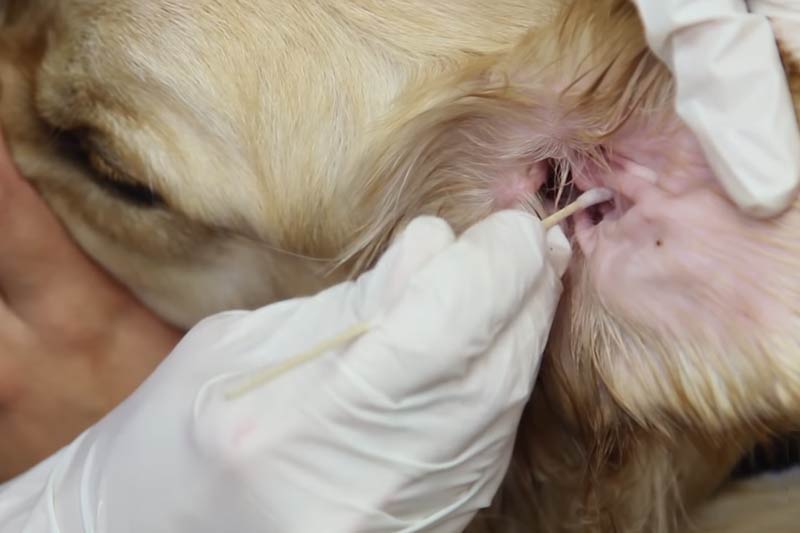
Q&A
The normal color of dog earwax is light brown or medium brown, although it can also be yellowish at times. As long as the earwax is not accompanied by a foul smell, it is likely normal. Bad odor and the different colors mentioned above indicate unhealthy earwax that’s probably caused by an infection.
If your dog’s earwax goes along the shades of brown to yellow, there’s nothing to worry about. However, do keep an eye out for signs of inflammation on the dog’s ears, which could also be another problem.
The most common reason why dog earwax can smell bad is that it hasn’t been cleaned in a while. Too much earwax will result in a bad smell and could even give your dog an ear infection if you haven’t cleaned it for a long time.
Yeast infection is among the most common reasons for stinky odor in your dog’s ears. This infection is often coupled with excessive scratching or an inflamed appearance. If your dog breed is likely to get skin allergies, always inspect their ear from time to time.
Ear infections can cause a dog to have an excessive amount of earwax. In some cases, it could also be due to frequently getting into the water. Excessive earwax is likely to make the dog more prone to parasites as well.
Some allergies can also make dogs produce excessive earwax, which is caused by ear infections. If you suspect that your dog has a lot of earwax all the time, it’s best to consult your vet about it.
Yes, but make sure that it is specifically formulated for dogs. Human formulas are typically harsh so they shouldn’t be used on your canine friend to avoid worsening the infection further. Always read the instructions on the amount and the usage.
If you want to use an earwax removal solution for your dog, consider consulting your vet first. They will give you a better recommendation based on the breed of your dog, as well as if their eardrum is intact. Some dogs require milder formulations when it comes to ear-cleaning.
Aside from not cleaning your dog’s ears often, your dog could have some form of allergies or underlying ear infections. Such problems could cause your dog to have an excessive build-up of earwax. Your dog might also have some mites that could produce red-colored earwax.
Another reason for your dog excessively building up earwax is their scratching habits. Your dog will likely get an ear infection if they scratch their ears too often, but you can remedy this by putting them in a soft collar to prevent them from touching their ears. This habit will take a while to break, though.
So, how can you tell if your dog has ear mites or simply earwax? First, as we mentioned above, mites can be characterized by excessive inflammation of the ears, too much scratching, and a blackish-brown discharge or color of the earwax.
If your dog typically has upright ears, they might also droop if they have mites. It is also likely that your dog’s eardrums are damaged if they have mites, although it’s best to check with a local vet to diagnose your dog properly. That’s because dog mites can only be observed under a microscope.
The amount of normal earwax depends on the dog breed, as some produce more earwax than others. For instance, poodles, English bulldogs, and bassets are likely to get ear infections, which leads to too much earwax.
If you aren’t sure if your dog has too much or just the right amount of earwax, check with your veterinarian. They will ask you questions about how often you clean your dog’s ears and they will also perform a visual inspection of your dog’s ears.
If the earwax in your dog’s ears isn’t cleaned or managed properly, they could lose their hearing, although this is typically only temporary. After you have cleaned the ears and have them professionally treated if there’s an infection, your dog’s hearing will likely return to normal.
However, permanent hearing loss can also be a possibility. This usually happens if the dog is a senior or if there has been a severe injury or infection that hasn’t been treated early. Hearing loss is on a case-to-case basis when it comes to dogs and earwax.
